A bench sander, also known as a stationary sander, is a versatile power tool that is a staple in any woodworking shop. It is typically mounted on a workbench or stand, hence the name. This tool is designed to smooth and finish surfaces, making it an essential part of any woodworking project.
Unlike handheld sanders, bench sanders provide a stable platform that allows for more precise and efficient sanding. They are equipped with a sanding belt or disc that rotates at high speed, removing material from the surface of the workpiece. This results in a smooth, even finish that is difficult to achieve with manual sanding.
Whether you are a professional woodworker or a DIY enthusiast, a bench sander can significantly improve the quality of your work. It can handle a wide range of materials, from wood and metal to plastic and composite. With the right bench sander, you can take your projects to the next level.
Our Top Bench Sanders Picks
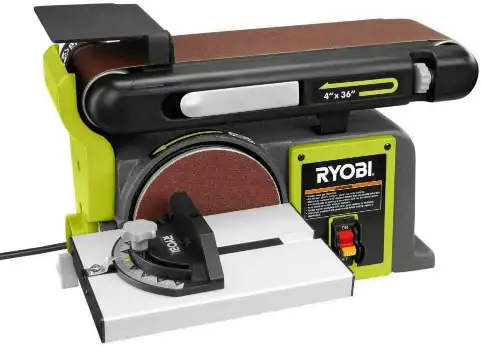
RYOBI BD4601G Bench Sander Green
Check on AmazonKey Specs:
- Adjustable belt arm (0°-90°)
- Tool-free belt tension release
- Cast iron base for stability
- Integrated dust port
- Miter gauge included
The RYOBI BD4601G Bench Sander combines versatility and power, making it ideal for both vertical and horizontal sanding. Its adjustable belt arm and tool-free belt tension release ensure effortless operation. With a stable cast iron base and integrated dust port, it provides a smooth, clean sanding experience. Perfect for DIYers and professionals looking for efficiency and durability in their workshop.
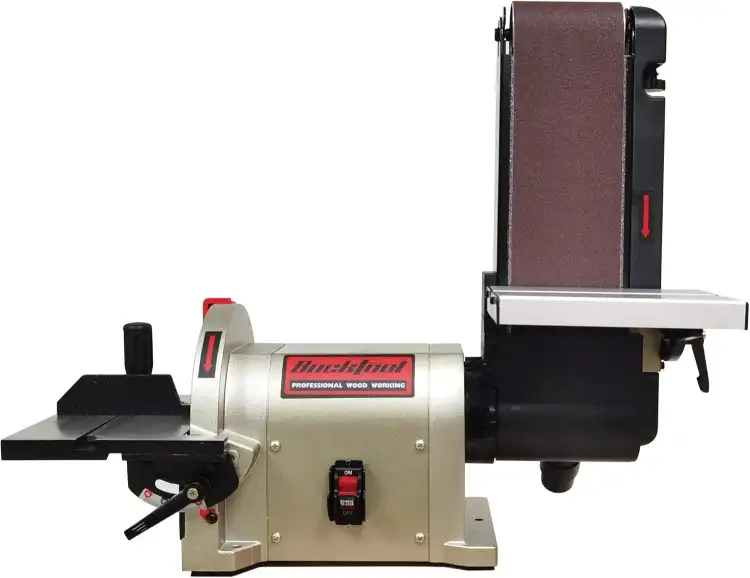
BUCKTOOL Direct Drive Bench Belt
Check on AmazonKey Specs:
- 3/4 HP motor with 3450 RPM disc speed
- 4×36-inch adjustable belt (horizontal/vertical)
- 8-inch disc with stable performance
- Adjustable work tables (0-45° tilt)
- Dual dust ports for dust-free operation
The BUCKTOOL Direct Drive Bench Belt Sander offers high efficiency with a powerful 3/4 HP motor delivering stable output at 3450 RPM. Its 4×36-inch belt is versatile, adjustable for horizontal or vertical use, and combined with a 8-inch disc for stable performance. Featuring two adjustable work tables and dust collection ports, this sander ensures a clean, precise workspace. Ideal for woodworking, its durable design provides ease and reliability for both professionals and DIYers.
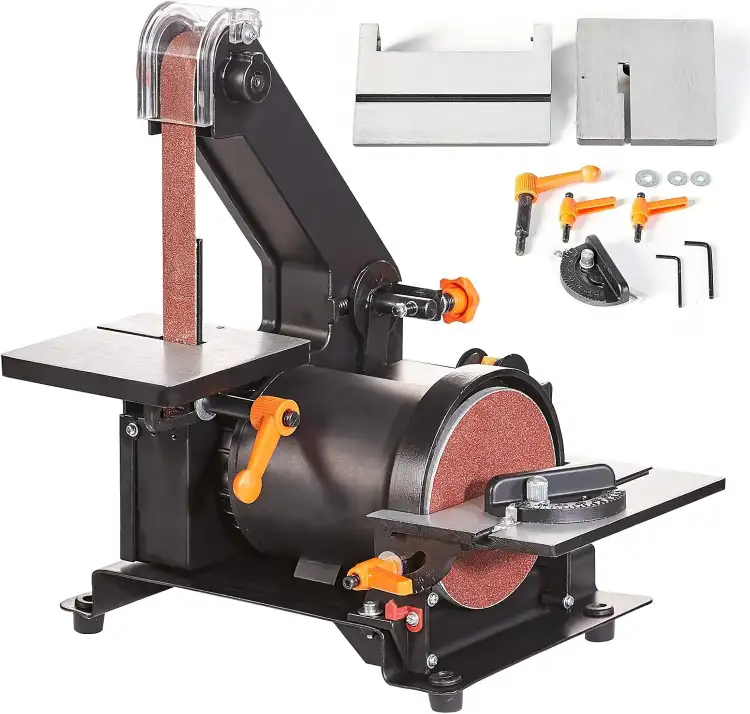
VEVOR 1 x 30 Inch Belt Sander
Check on AmazonKey Specs:
- 2.5A induction motor with 3500 RPM speed
- 1″ x 30″ belt and 5″ disc sanding combo
- Adjustable 0-45° cast aluminum worktable
- Steel base with rubber foot for stability
- Dust collection port for cleaner workspace
The VEVOR 1 x 30 Inch Belt Sander delivers powerful performance with a 2.5A induction motor and 3500 RPM speed. Its versatile design includes a 1″ x 30″ belt and 5″ disc for precise sanding of wooden workpieces. The adjustable 0-45° cast aluminum worktable accommodates various sizes, offering flexibility for different sanding tasks. Its steel plate base and rubber foot provide stability, while the dust collection port ensures a clean, dust-free workspace.
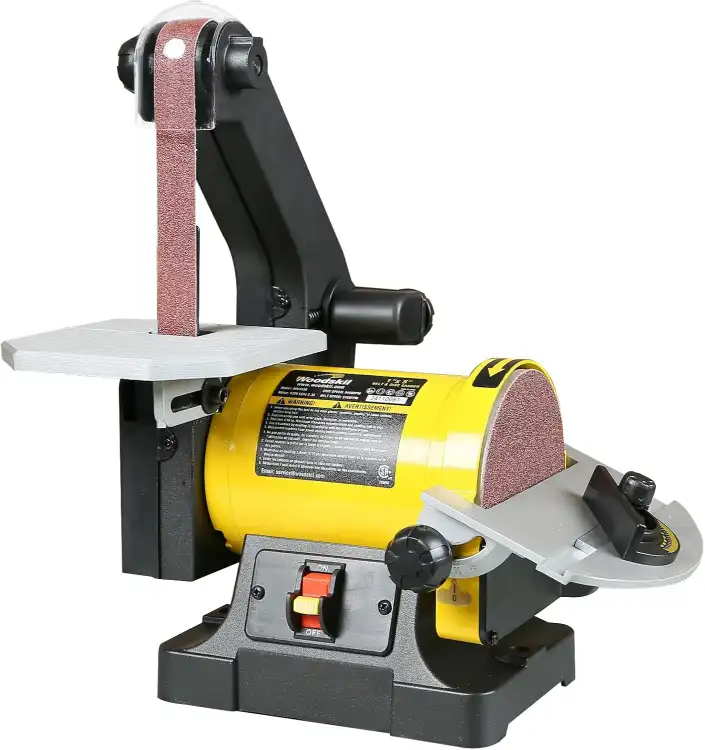
Belt and Disc Sander for Woodworking
Check on AmazonKey Specs:
- Direct-driven motor with 3160 FPM belt speed and 3450 RPM disc speed
- 1 x 30-inch belt and 5-inch disc for dual sanding options
- Adjustable work table with miter gauge
- Two dust exhaust ports for clean operation
- CSA certified with dual safety switches
The Belt and Disc Sander for Woodworking combines power and efficiency with a direct-driven motor delivering 3160 FPM for the belt and 3450 RPM for the disc. Its two-in-one design includes a 1 x 30-inch belt and 5-inch disc for versatile sanding. The adjustable work table with a miter gauge ensures precision. Easy to assemble with minimal maintenance, this sander also features dual dust exhaust ports and safety switches for improved operation.
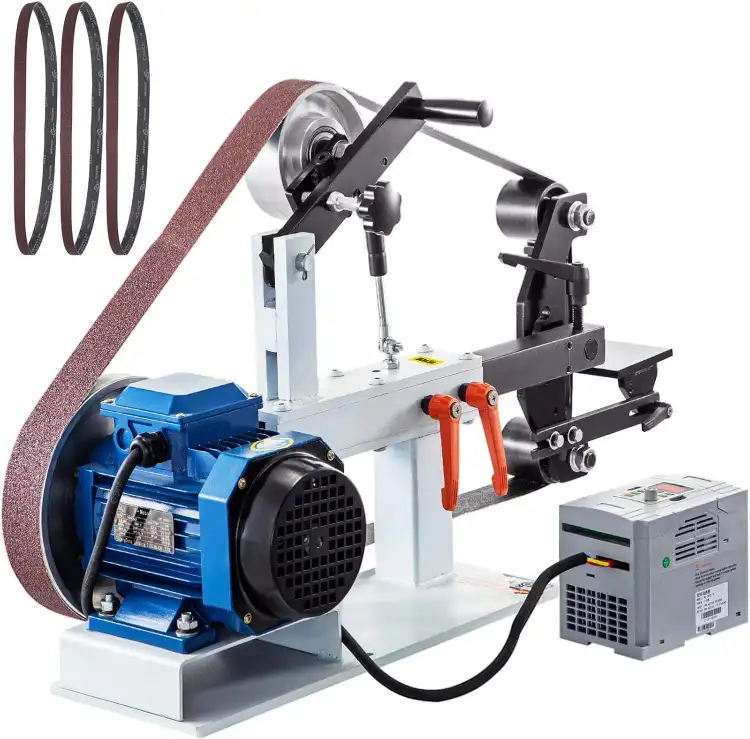
Happybuy 2Hp Belt Grinder 2 x 82inch Variable Speed Belt Sander
Check on AmazonKey Specs:
- 3-in-1 grinding types: Circular, arc, flat
- 1500W motor with variable speed (0-2800 RPM)
- 2″ x 82″ adjustable belt size
- All-steel construction for durability
- Suitable for grinding metal, wood, and acrylic
The Happybuy 2Hp Belt Grinder offers a 3-in-1 grinding solution with the flexibility for circular, arc, and flat grinding. Equipped with a 1500W powerful motor, it runs at a variable speed of 0-2800 RPM for stable performance. Its all-steel construction ensures durability, while the 2″ x 82″ belt size is easy to adjust and replace. This versatile sander excels in grinding metal, wood, and acrylic, making it ideal for various industrial applications.
Understanding the Purpose of a Bench Sander
The primary purpose of a bench sander is to smooth and finish surfaces. It achieves this by removing material from the workpiece through abrasion. The abrasive surface of the sanding belt or disc grinds away the rough edges and imperfections, resulting in a smooth, even finish.
However, a bench sander is not just for finishing. It can also be used for shaping and sizing. By adjusting the angle of the sanding belt or disc, you can shape the workpiece to your desired dimensions. This makes a bench sander a versatile tool that can handle a variety of tasks.
Moreover, a bench sander can also be used for removing rust and paint. The abrasive action of the sanding belt or disc can easily strip away rust and old paint, preparing the surface for a new coat. This makes a bench sander an invaluable tool for restoration and renovation projects.
Different Types of Bench Sanders
There are several types of bench sanders, each designed for a specific purpose. The most common types are belt sanders, disc sanders, and combination sanders.
Belt sanders are equipped with a continuous loop of sandpaper, known as a sanding belt. They are ideal for sanding large, flat surfaces and removing a lot of material quickly. Disc sanders, on the other hand, have a circular sanding disc. They are perfect for precision sanding and finishing.
Combination sanders, as the name suggests, combine a belt sander and a disc sander in one unit. They offer the best of both worlds, making them a versatile choice for any workshop. Other types of bench sanders include spindle sanders, which are designed for sanding curved surfaces, and oscillating sanders, which move the sanding belt or disc back and forth for a smoother finish.
Key Features to Look for in a Bench Sander
When choosing a bench sander, there are several key features to consider. The first is the size of the sanding belt or disc. The larger the size, the more surface area it can cover, resulting in faster sanding. However, a larger size also means a larger tool, which may not be suitable for smaller workshops.
The second key feature is the motor power. The more powerful the motor, the faster the sanding belt or disc can rotate, resulting in more efficient sanding. However, a more powerful motor also means a louder tool, which may not be ideal for residential areas.
The third key feature is the adjustability of the sanding belt or disc. The ability to adjust the angle and position of the sanding belt or disc allows for more versatile sanding. This is especially important for shaping and sizing tasks.
The Importance of Power and Speed in Bench Sanders
Power and speed are crucial factors in the performance of a bench sander. The power of the motor determines the speed of the sanding belt or disc, which in turn determines the rate of material removal. A more powerful motor can rotate the sanding belt or disc at a higher speed, resulting in faster and more efficient sanding.
However, power and speed are not everything. Too much power and speed can result in excessive material removal, damaging the workpiece. Therefore, it is important to choose a bench sander with adjustable speed. This allows you to control the rate of material removal, ensuring a smooth and even finish.
Moreover, a more powerful motor also means a louder tool. If noise is a concern, you may want to consider a bench sander with a quieter motor. However, keep in mind that a quieter motor may not be as powerful.
Understanding the Size and Weight of Bench Sanders
The size and weight of a bench sander are important factors to consider, especially if space is a concern. A larger bench sander can cover more surface area, resulting in faster sanding. However, it also takes up more space, which may not be ideal for smaller workshops.
The weight of a bench sander affects its stability. A heavier bench sander is more stable, reducing the risk of tipping over during operation. However, it is also more difficult to move around, which may be a problem if you need to transport the tool frequently.
Therefore, when choosing a bench sander, you need to balance the size and weight with your needs and constraints. If space is limited, you may want to consider a compact bench sander. If stability is a concern, you may want to opt for a heavier bench sander.
The Role of Dust Collection in Bench Sanders
Dust collection is an important feature in a bench sander. Sanding produces a lot of dust, which can be harmful if inhaled. A bench sander with a good dust collection system can help keep your workshop clean and safe.
A dust collection system typically consists of a dust port and a dust bag or canister. The dust port connects to the sanding belt or disc, collecting the dust as it is produced. The dust bag or canister stores the collected dust, preventing it from spreading in the air.
When choosing a bench sander, look for one with a large dust port and a high-capacity dust bag or canister. This ensures efficient dust collection, reducing the need for frequent emptying. Also, consider the ease of emptying the dust bag or canister. A bench sander with an easy-to-empty dust collection system can save you a lot of time and effort.
The Significance of Durability and Build Quality
Durability and build quality are crucial factors in the longevity of a bench sander. A durable bench sander can withstand the rigors of heavy use, ensuring a long service life. The build quality, on the other hand, affects the performance and reliability of the tool.
A bench sander with a sturdy metal construction is more durable than one with a plastic construction. Metal is more resistant to wear and tear, ensuring a longer lifespan. However, it is also heavier, which may be a problem if portability is a concern.
The build quality of a bench sander is reflected in its design and craftsmanship. A well-designed bench sander is easy to use and maintain, while a well-crafted bench sander performs reliably and efficiently. Therefore, when choosing a bench sander, pay attention to the durability and build quality.
The Impact of Noise Level on Your Bench Sander Choice
Noise level is an important factor to consider when choosing a bench sander. A loud bench sander can be disruptive, especially in residential areas. Therefore, it is important to choose a bench sander with a reasonable noise level.
The noise level of a bench sander is determined by the motor and the sanding belt or disc. A more powerful motor is usually louder, while a faster rotating sanding belt or disc produces more noise. Therefore, if noise is a concern, you may want to consider a bench sander with a quieter motor and a slower rotating sanding belt or disc.
However, keep in mind that a quieter bench sander may not be as powerful or efficient. Therefore, you need to balance the noise level with the performance and efficiency of the tool. If necessary, you can use ear protection to reduce the impact of noise.
The Role of Safety Features in Bench Sanders
Safety is paramount when using a bench sander. This power tool can be dangerous if not used properly. Therefore, it is important to choose a bench sander with adequate safety features.
One important safety feature is a sturdy base or stand. This ensures the stability of the bench sander, reducing the risk of tipping over during operation. Another important safety feature is a safety switch or lock. This prevents accidental start-up, reducing the risk of injury.
Other safety features to look for include a dust collection system, which protects against dust inhalation, and a guard or shield, which protects against flying debris. A bench sander with these safety features can provide a safer and more comfortable working environment.
Importance of Ease of Use and Comfort in Bench Sanders
Ease of use and comfort are important factors to consider when choosing a bench sander. A bench sander that is easy to use and comfortable to operate can make your work more enjoyable and less tiring.
Ease of use is determined by the design and features of the bench sander. A well-designed bench sander is intuitive to use, with controls that are easy to understand and operate. Features that enhance ease of use include adjustable speed, which allows you to control the rate of material removal, and tool-free belt changes, which save you time and effort.
Comfort is determined by the ergonomics of the bench sander. A comfortable bench sander has a well-balanced design, with handles that are easy to grip and controls that are easy to reach. Features that enhance comfort include vibration reduction, which reduces hand fatigue, and noise reduction, which reduces ear discomfort.
Considering the Brand and Warranty of Bench Sanders
The brand and warranty of a bench sander are important factors to consider. A reputable brand is more likely to produce a high-quality bench sander, while a good warranty can provide peace of mind.
Reputable brands have a track record of producing reliable and durable bench sanders. They also offer good customer service, providing support and assistance when needed. Therefore, when choosing a bench sander, consider the reputation of the brand.
A good warranty protects against defects and malfunctions. It ensures that the bench sander will be repaired or replaced if it fails under normal use. Therefore, when choosing a bench sander, consider the length and coverage of the warranty.
Price Range and Value for Money in Bench Sanders
The price range of bench sanders varies widely, from budget models to high-end models. The price is determined by the features, performance, and quality of the bench sander. Therefore, it is important to consider the value for money when choosing a bench sander.
A budget bench sander may be affordable, but it may not have the features or performance you need. On the other hand, a high-end bench sander may have all the bells and whistles, but it may be overkill for your needs. Therefore, the best value for money is a bench sander that meets your needs at a price you can afford.
When comparing prices, consider the total cost of ownership. This includes the cost of the bench sander, as well as the cost of consumables like sanding belts or discs, and the cost of maintenance and repairs. A bench sander with a lower total cost of ownership may be a better value for money in the long run.
Maintenance and Care for Bench Sanders
Maintenance and care are crucial for the longevity and performance of a bench sander. Regular maintenance can prevent problems and extend the lifespan of the tool, while proper care can ensure its reliability and efficiency.
Maintenance for a bench sander typically involves cleaning and lubrication. Cleaning removes dust and debris that can clog the tool and impair its performance, while lubrication reduces friction and wear, extending the lifespan of the tool. Therefore, it is important to clean and lubricate your bench sander regularly.
Care for a bench sander involves proper use and storage. Proper use means following the manufacturer’s instructions and safety guidelines, while proper storage means keeping the tool in a dry and dust-free environment. Therefore, it is important to use and store your bench sander properly.
Conclusion: Making the Right Choice for Your Bench Sander Needs
Choosing the right bench sander can be a daunting task, given the wide range of options available. However, by understanding the purpose of a bench sander, considering the key features, and weighing the pros and cons, you can make an informed decision.
The right bench sander for you depends on your needs and constraints. If you need a versatile tool for a variety of tasks, a combination sander may be the best choice. If space is a concern, a compact bench sander may be the best option. If you value comfort and ease of use, a bench sander with ergonomic design and user-friendly features may be the best fit.
Regardless of your choice, remember that a bench sander is an investment. Therefore, choose a bench sander that is durable, reliable, and offers good value for money. With the right bench sander, you can improve the quality of your work and enjoy your woodworking projects more.
FAQs
What is a bench sander used for?
A bench sander is used for smoothing and finishing surfaces. It can also be used for shaping and sizing, as well as removing rust and paint.
What are the different types of bench sanders?
The different types of bench sanders include belt sanders, disc sanders, combination sanders, spindle sanders, and oscillating sanders.
What should I look for in a bench sander?
When choosing a bench sander, look for key features such as the size of the sanding belt or disc, the power of the motor, the adjustability of the sanding belt or disc, the dust collection system, the durability and build quality, the noise level, the safety features, the ease of use and comfort, the brand and warranty, and the price and value for money.
How do I maintain and care for a bench sander?
Maintain and care for a bench sander by cleaning and lubricating it regularly, using it properly, and storing it in a dry and dust-free environment.
How do I choose the right bench sander for my needs?
Choose the right bench sander for your needs by understanding the purpose of a bench sander, considering the key features, and weighing the pros and cons. Also, consider your needs and constraints, such as the type of tasks you need to perform, the space available in your workshop, and your budget.
